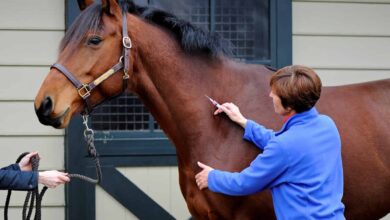By Ahmed Yousef,
Stables are an essential part of horse care, serving not just as a shelter but as a complete environment that helps improve a horse’s health and well-being. The design and construction of modern stables aim to provide the best possible environment for horses, focusing on comfort, cleanliness, and safety. In this article, we will discuss the best practices for building and maintaining modern, healthy stables to ensure the best care for horses.
Planning for a Healthy Stable
- Choosing the Right Location: Choosing the right location is one of the most important steps when building a stable. The site should be away from sources of noise and pollution and should have good water drainage. Ideally, it should be close to pastures or open spaces where horses can relax and exercise.
- Good Stable Design: The design should focus on providing sufficient space for each horse, considering that horses need freedom of movement inside the stable. Doors should be wide enough to allow horses to pass safely, and windows should be present to provide natural light and ventilation.
- Ventilation and Lighting: Proper ventilation is essential to prevent the buildup of harmful odors and fumes, such as ammonia from urine. Windows or ventilation openings should be designed to allow fresh air to enter and stale air to leave. Natural lighting also helps improve horses’ moods and should be supplemented with suitable artificial lighting at night.
- Using Safe Building Materials: Non-toxic and safe materials should be used in stable construction. Floors should be non-slip and easy to clean. Materials that may cause injuries or allergies to horses should be avoided.
Best Practices for Stable Maintenance
- Regular Cleaning: Cleanliness is the key to maintaining the health of horses inside the stable. Stables should be cleaned daily to remove manure and urine and to prevent the buildup of harmful odors. Clean and appropriate bedding helps improve horse comfort and reduces the risk of diseases.
- Disinfection and Pest Control: Regular disinfection of stables is important to prevent the spread of germs and bacteria. Safe veterinary disinfectants can be used, and pest control programs should be implemented to deal with insects and rodents that may cause diseases.
- Maintenance of Equipment and Infrastructure: Doors, fences, and equipment used inside the stable should be regularly inspected to ensure their safety. Regular checks help detect any problems before they escalate and cause injuries to horses or caretakers.
Providing a Comfortable and Safe Environment for Horses
- Suitable Bedding: Bedding is a vital element in ensuring horse comfort inside the stable. It should be soft and absorb moisture well. Straw or wood shavings can be used, and bedding should be changed regularly to maintain a clean environment.
- Sufficient Space for Movement: The stable should have enough space for the horse to move freely and lie down comfortably. Horses kept in confined spaces for long periods may suffer from physical and psychological issues.
- Clean Water and Feed: Clean and fresh water should be provided to horses at all times. Feed areas should be designed to ensure easy access for horses without risk of injury or contamination.
Environmental Considerations
- Proper Drainage: Proper drainage of rainwater and water used for cleaning is necessary to keep the stable dry and prevent moisture buildup, which could lead to health problems.
- Waste Recycling: Organic waste generated by horses can be recycled and used as fertilizer, contributing to sustainability and reducing the environmental impact of the stable.
Technology in Modern Stables
- Automatic Feeding Systems: Automatic feeding systems help provide feed and water to horses regularly without constant manual intervention, ensuring that horses’ nutritional needs are met consistently.
- Surveillance Camera Systems: Installing surveillance cameras in stables helps monitor the horses’ condition around the clock. This allows caretakers to observe any unusual behavior or detect injuries quickly.
- Environmental Sensors: Sensors are used to monitor air quality, temperature, and humidity inside the stable. These devices help maintain optimal conditions for horse health and comfort.
Building and maintaining modern, healthy stables require careful planning and attention to detail to provide a safe and comfortable environment for horses. By applying best practices in design, cleaning, and maintenance, the quality of life for horses can be improved, ensuring their well-being. Additionally, the use of modern technology enhances the efficiency of stable management and ensures the long-term health of horses.








